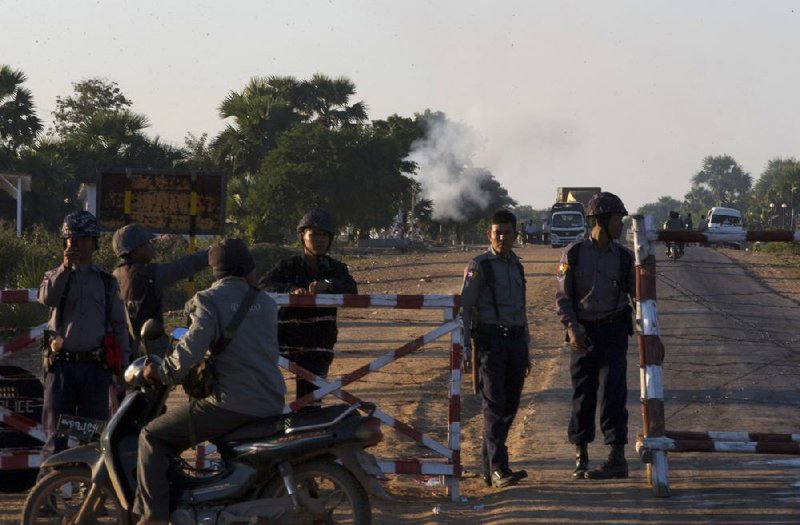MONYWA, Burma — Security forces used water cannons, tear gas and smoke bombs Thursday to clear protesters from a copper mine in northwestern Burma, wounding villagers and Buddhist monks in the biggest use of force against demonstrators since the reformist government of President Thein Sein took office last year.
Opposition leader Aung San Suu Kyi, who arrived in the area hours later on a previously scheduled visit, said she would try to negotiate a solution.
In a statement broadcast on state television, the government initially acknowledged using the riot-control measures but denied using excessive force. In an unusual move, it later retracted the statement without explanation.
Monks and other protesters had serious burns after the crackdown at the Letpadaung mine near the town of Monywa. Protesters who oppose the mine’s impact on villagers and the environment had occupied the area for 11 days.
“I didn’t expect to be treated like this, as we were peacefully protesting,” said Aung Myint Htway, a peanut farmer whose face and body were covered with black patches of burned skin.
The police action risks becoming a public-relations and political fiasco for Thein Sein’s government, which has been touting its transition to democracy after almost five decades of repressive military rule.
“This is unacceptable,” said Ottama Thara, a 25-year-old monk who was at the protest. “This kind of violence should not happen under a government that says it is committed to democratic reforms.”
“Around 2:30 a.m. police announced they would give us five minutes to leave,” Aung Myint Htway said. He said police fired water cannons first and then shot what he and others called flare guns.
“They fired black balls that exploded into fire sparks. They shot about six times. People ran away and they followed us,” he said, still writhing hours later from pain. “It’s very hot.”
Photos of the wounded monks showed they had suffered serious burns. It was unclear what sort of weapon caused them, or whether the burns occurred when protesters’ shelters caught fire from whatever devices police used.
The government had defended its actions in a statement issued by the government’s official information office Thursday afternoon. It denied using excessive force and said it used fire hoses, tear gas and smoke bombs according to international standards for riot control. The statement declared that the authorities took action for the sake of rule of law and in the interests of the country and its people, and said the project operated in accordance with international environmental standards.
Later, however, the president’s office issued a one-sentence statement recalling the information office’s statement without explanation.
Suu Kyi’s visit to nearby Kan-Kone village had been scheduled before the crackdown. The Nobel Peace laureate, elected to parliament after spending most of the past two decades under house arrest, unexpectedly went to the mine to meet with its operators before making her speech.
“I already met one side. I met with mine operators. I want to meet with villagers and protesters,” she said. “I want to negotiate hearing from both sides.”
She asked the crowd to be patient. “I haven’t made any decision yet. I want to meet with both sides and negotiate,” she said in a speech that lasted less than 15 minutes. “Will you agree with my negotiating?” The crowd shouted its assent.
After her speech she went to the hospital where many of the injured were being treated and met with protest leaders at the hotel in Monywa where she is staying. Thwe Thwe Win, a female protest leader, said afterward: “We will wait for Aung San Suu Kyi to negotiate with the companies. But we will not stop the protest until we achieve our demands, though I cannot tell you how we will proceed at this point.”
Ohn Kyaing, a spokesman for Suu Kyi’s National League for Democracy party, said she told the mine’s executives that force should not have been used. He said the executives said they did not direct the action, and that it had been the work of the state security forces. Ohn Kyaing said Suu Kyi today would meet with officials in charge of the crackdown, as well as local villagers and their representatives.
Villagers affected by the mine claim they did not receive satisfactory compensation and demand a more comprehensive environmental impact assessment.
The mine, which is being expanded, is a joint venture between a Chinese company and a holding company controlled by Burma’s military.
According to a nurse at a Monywa hospital, 27 monks and one other person were admitted with burns caused by some sort of projectile that released sparks or embers. Two monks with serious injuries were sent for treatment in Mandalay, Burma’s second-biggest city, a 21/2-hour drive away.
Burma is often called Myanmar, a name that ruling military authorities adopted in 1989. Suu Kyi and other regime opponents have refused to adopt the name change, as have the U.S. and Britain.
Front Section, Pages 6 on 11/30/2012
